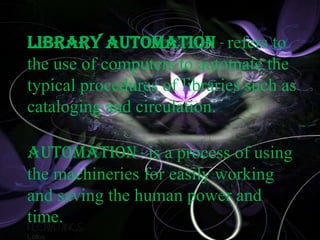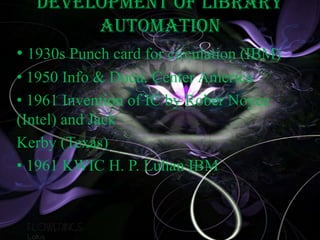Presentation1 at lis 101
- 1. Library Automation Prepared to: Mam rose Prepared by: Hannah may rosales
- 2. Library automation - refers to the use of computers to automate the typical procedures of libraries such as cataloging and circulation. Automation - is a process of using the machineries for easily working and saving the human power and time.
- 3. Main purpose of Library Automation âĒ to free the librarians and library staff and to allow them to contribute more meaningfully to spread of knowledge and Information.
- 4. Library Computerization Computerization - is the part of library automation. At present use of the computer technology for library keeping operation such as administrative works acquisition,cataloguing, circulation, serial control, OPAC
- 5. Development of Library Automation âĒ 1930s Punch card for circulation (IBM) âĒ 1950 Info & Docu. Center America âĒ 1961 Invention of IC by Rober Noyce (Intel) and Jack Kerby (Texas) âĒ 1961 KWIC H. P. Luhan IBM
- 6. âĒ 1966 MARC-I and in 1968 it was converted in MARC-II by Henriette Avram âĒ1965 Indian Science Abstract: author index by INSDOC âĒ1970s Many library networks establish in India
- 7. Need of LibraryAutomation âĒ Information explosion âĒ Availability of information in various formats (Print, nonprint,graphical, audio-visual etc.) âĒ Different approaches and needs of user âĒ Limitation of library (time, space & human power)
- 8. âĒ Duplication in house keeping operation âĒ To well management and retrieval of information âĒ To search national and international database âĒ Impact of communication technology âĒ Increasing numbers of users
- 9. Content of Library Automation âĒ To Obtain increased operational efficiencies âĒ To improve the quality, speed and effectiveness of services âĒ To improve access the resources on other networks and systems, including the Web
- 10. âĒ To improve the management of their physical and financial resources âĒTo facilitate wider dissemination of their information products and services âĒ Enable their participation in resource- sharing library networks
- 11. Objectives of Library Automation âĒSpeedily disposal of library work âĒ Establishment of a well storage & retrieval system âĒTime and human power saving with qualitative services âĒSuitability for library cooperation & coordination development
- 12. âĒ Simplicity in library management to meet the objectives âĒ Proper use of human resources âĒ Development of the new library services âĒ Preparation of reports and correspondence âĒSuitability for resource sharing and networking âĒ Development of human resources
- 13. Special Features of Library Automation âĒIt is an electronics based activity which is carried out by human beings âĒ It is helpful to providing library services âĒ Standardization in library work âĒ Accuracy in work âĒ Speedily communication of information âĒ Avoid duplication in the library work
- 14. âĒ Trained staff âĒ Availability of information âĒ It is a time saving system âĒ User friendly system âĒ Networking
- 15. Requirements for LibraryAutomation âĒ Adequate collection âĒ Financial assistance âĒHardware âĒSoftware âĒTrained staff âĒUser training âĒMaintenance & development
- 16. Advantages of Library Automation âĒ Easily searching of information âĒ Time saving âĒ Speedily communication âĒ Helpful in stock verification âĒ Easily working with the help of automation âĒ Helpful in resource sharing âĒ It motivate to library staff âĒ Development of human resource
- 17. Disadvantages of Library Automation âĒ It is long term and time consuming process âĒ Financial expenses âĒ Continuous staff training are required for it âĒ Security problems âĒ It is totally depended on the electricity âĒ Costly maintenance âĒ Untrained users
- 18. THANK YOU!!!!

















